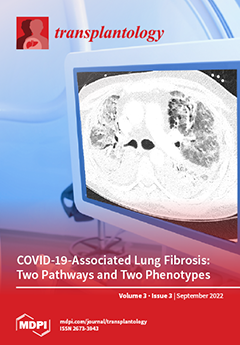Background: Early reports of COVID-19 in lung transplant recipients (LTRs) showed high hospitalization and mortality rates. However, the outcomes of COVID-19 in LTRs since the advent of newer therapies and vaccines have been poorly defined.
Methods: We evaluated the risks for SARS-CoV-2-related hospitalization
[...] Read more.
Background: Early reports of COVID-19 in lung transplant recipients (LTRs) showed high hospitalization and mortality rates. However, the outcomes of COVID-19 in LTRs since the advent of newer therapies and vaccines have been poorly defined.
Methods: We evaluated the risks for SARS-CoV-2-related hospitalization and mortality in a cohort of LTRs at the Henry Ford Lung Transplant Program in Detroit, Michigan during the study period March 2020–March 2022. Univariate logistic regression, followed by multivariable modeling were performed to estimate the odds ratio (OR) with 95% confident intervals (CI).
Results: Sixty-four laboratory-confirmed SARS-CoV-2 infections were identified in 59 patients. For the primary analysis of the hospitalization and mortality risks, we included these 59 patients with symptomatic COVID-19. SARS-CoV-2 infections were confirmed with real-time polymerase chain reaction (RT-PCR) from a nasopharynx swab. The mean age (±STD) was 61 (±12), 63% were males, 27% were African Americans, and the time from lung transplant to COVID-19 was 5.5 (±4.8) years. Thirty-four (57.6%) patients were hospitalized, and the inpatient mortality rate was 24% (8/34). A multivariable analysis showed that patients with a higher baseline forced expiratory volume (FEV1) were less likely to be hospitalized (OR = 0.91 and 95% CI 0.87–0.98,
p = 0.02). Seventy-five percent (75%; 6/8) of patients on invasive mechanical ventilation died, compared with only 8% mortality rate in those without mechanical ventilation (OR = 36.0 and 95% CI 4.2–310.4,
p < 0.01). Although a trend toward a higher risk of death was observed in those infected during the Alpha (
p = 0.17) and Delta (
p = 0.22) waves, no significant risk was detected after adjusting for other covariates. Five LTRs were diagnosed with COVID-19 twice. Thirty of the sixty-four COVID-19 cases (46.8%) occurred in LTRs that had received at least two doses of any of the available mRNA vaccines at a median of 123 days (IQR 98–164 days) after vaccination. Twelve of the thirty (40%) were hospitalized, and four patients (33%) died during their hospitalizations.
Conclusions: In our LTR population, the hospitalization and mortality rates associated with COVID-19 were high despite the increased use of new therapies. Vaccine-breakthrough infections were common and were associated with poor outcomes. Studies are needed to determine optimal prevention and therapeutic strategies to improve COVID-19 outcomes in LTRs.
Full article




